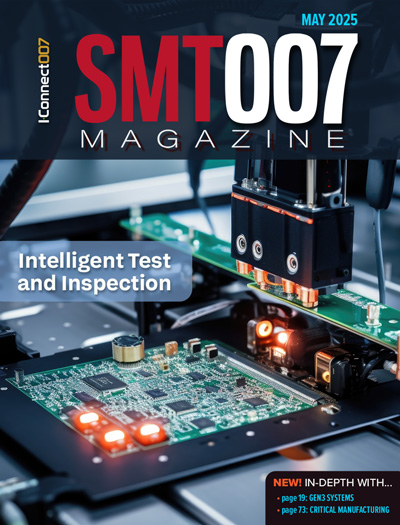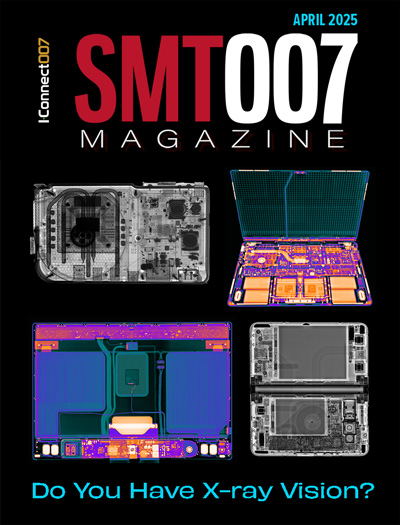-

- News
- Books
Featured Books
- smt007 Magazine
Latest Issues
Current Issue
Moving Forward With Confidence
In this issue, we focus on sales and quoting, workforce training, new IPC leadership in the U.S. and Canada, the effects of tariffs, CFX standards, and much more—all designed to provide perspective as you move through the cloud bank of today's shifting economic market.

Intelligent Test and Inspection
Are you ready to explore the cutting-edge advancements shaping the electronics manufacturing industry? The May 2025 issue of SMT007 Magazine is packed with insights, innovations, and expert perspectives that you won’t want to miss.

Do You Have X-ray Vision?
Has X-ray’s time finally come in electronics manufacturing? Join us in this issue of SMT007 Magazine, where we answer this question and others to bring more efficiency to your bottom line.
- Articles
- Columns
Search Console
- Links
- Media kit
||| MENU - smt007 Magazine
BAE Systems’ Enhanced M-Code Global Navigation Satellite System Technology Reaches Major Development Milestone
February 1, 2024 | BAE SystemsEstimated reading time: 1 minute
BAE Systems’ program to design and manufacture an advanced military GPS receiver and next-generation semiconductor has completed Critical Design Review (CDR).
The Military GPS User Equipment (MGUE) Increment 2 Miniature Serial Interface (MSI) program is part of a $247 million contract received in 2020 from the U.S. Space Force.
The MSI includes a Next-Generation Application Specific Integrated Circuit (NG ASIC) which will provide enhanced security and performance of M-Code technology. It can also be easily transitioned into future BAE Systems M-Code GPS receivers.
“Clearing CDR is a major milestone that paves the way for smaller high-performance receivers on the battlefield,” said Luke Bishop, director of Navigation and Sensor Systems at BAE Systems. “We are one step closer to delivering our warfighters the next generation of Global Navigation Satellite System Position, Navigation and Timing.”
The MGUE Increment 2 program has two goals. The first is to develop an advanced, security certified M-Code NG ASIC, which provides assured Position, Navigation and Timing (PNT) in GPS jamming and spoofing environments, incorporates multi-Global Navigation Satellite System (GNSS) robustness, and reduces power consumption. This capability will support military users and weapon systems in airborne, maritime, and ground domains.
The second is to develop and qualify a small form-factor MSI GNSS receiver for use in applications requiring low size, weight, and power. This allows for easier integration into a wider range of platforms, including battery-powered dismounted applications.
The program is scheduled for completion in 2025 and will then be deployed to the U.S. and its allies. Work on the MGUE Increment 2 program is conducted at BAE Systems’ facility in Cedar Rapids, Iowa.
The company’s portfolio of M-Code GPS receivers provides flexible, efficient, and reliable navigation and guidance solutions for airborne systems, precision munitions, handheld receivers, and embedded applications.
Suggested Items
Maxar Space Systems Selected to Build High-Power EchoStar XXVI Satellite Share
06/02/2025 | BUSINESS WIREMaxar Space Systems, a trusted partner in satellite design and manufacturing, today announced it has been awarded a contract by EchoStar Corporation to manufacture EchoStar XXVI, a high-power geostationary communications satellite based on the Maxar 1300™ platform.
Global Smart Manufacturing Market Size to Reach $787.54 Billion by 2030
06/02/2025 | PRNewswireThe global Smart Manufacturing Market Size is projected to be valued at USD 297.20 billion in 2023 and reach $787.54 billion by 2030, growing at a CAGR of 14.9% according to a new report by The Research Insights.
Rolls-Royce to Provide Power, Handling System for Canadian River-class Destroyers
06/02/2025 | Rolls-RoyceRolls-Royce has reached agreement on a significant scope of work to support Batch One of the River-class destroyer (RCD) program for the Royal Canadian Navy.
L3Harris Receives Contract to Develop Next-Generation Security Processor for US Government
06/02/2025 | L3Harris TechnologiesL3Harris Technologies has been awarded a contract by the U.S. government to develop a next-generation security processor to secure communication devices across the globe.
OSI Systems Receives $47 Million Services Order for Security Inspection Systems
05/30/2025 | BUSINESS WIREOSI Systems, Inc. announced that its Security division received a $47 million order from a U.S. based customer to provide ongoing maintenance service for its installed base of Rapiscan® inspection systems that are utilized for screening baggage, cargo and vehicles.


